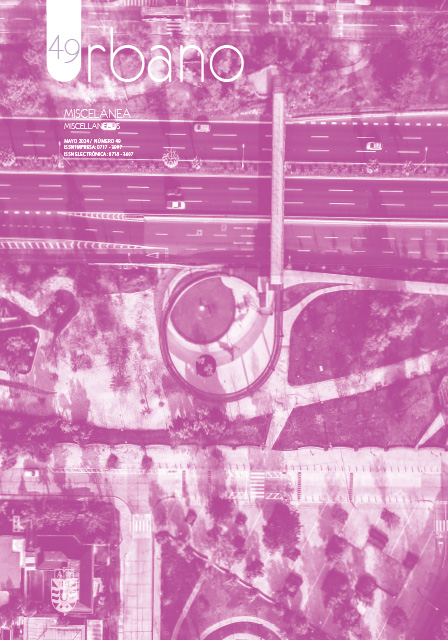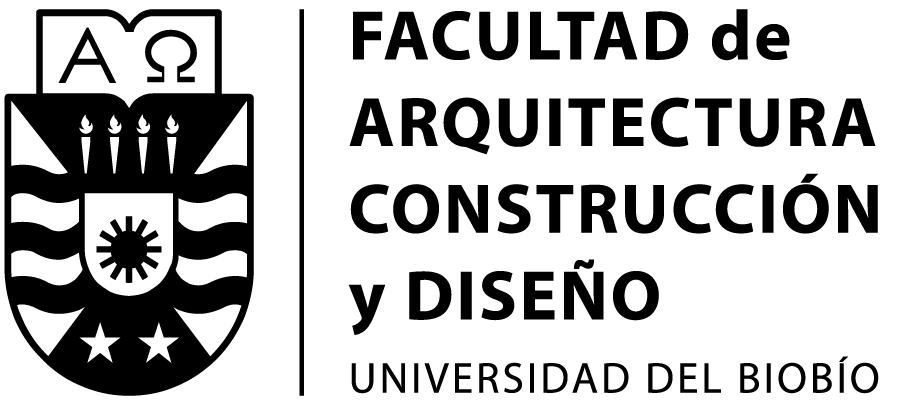Análisis espaciotemporal de islas de calor aplicado en la ciudad costera de San Francisco de Campeche, México
DOI:
https://doi.org/10.22320/07183607.2024.27.49.01Palabras clave:
islas, calor, ciudad, costaResumen
La urbanización de la ciudad de San Francisco de Campeche influye en la formación de isla de calor urbano debido a materiales de construcción, edificios y estructuras, actividades humanas, falta de vegetación, e infraestructura de transporte. Las islas de calor tienen consecuencias negativas como aumento en el consumo de energía y un mayor estrés térmico en la población. Además, contribuyen al cambio climático debido al aumento de emisiones de gases de efecto invernadero, causadas por la demanda adicional de energía. Ciudades como Sídney, Beijing, Nanjing, Moscú y Hong Kong están implementando estrategias de planificación urbana que promueven la vegetación urbana, el uso de materiales de construcción reflectantes, la mejora del transporte público y la promoción de la eficiencia energética en edificios. Con el fin de identificar islas de calor se utilizaron imágenes satelitales Landsat. Se analizó el crecimiento de la población y la mancha urbana realizando un análisis de índice de vegetación. En relación con los análisis realizados, se identificó que la temperatura ha aumentado aproximadamente 6°C entre los años 1990 y 2022; así como ha disminuido la vegetación ante el crecimiento de la mancha urbana y las viviendas, cuadruplicando el Índice de Vegetación de Diferencia Normalizada (NDVI) en la clase 0-0.25. Finalmente, se proponen medidas de mitigación para contrarrestar los efectos que causan las islas de calor en la ciudad.
Descargas
Citas
BESIR, A. B., y CUCE, E. (2018). Green roofs and facades: A comprehensive review. Renewable and Sustainable Energy Reviews, 82, 915–939. https://doi.org/10.1016/j.rser.2017.09.106
CHARABI, Y., y BAKHIT, A. (2011). Assessment of the canopy urban heat island of a coastal arid tropical city: The case of Muscat, Oman. Atmospheric Research, 101(1), 215–227. https://doi.org/https://doi.org/10.1016/j.atmosres.2011.02.010
CHEW, L. W., LIU, X., LI, X.-X., y NORFORD, L. K. (2021). Interaction between heat wave and urban heat island: A case study in a tropical coastal city, Singapore. Atmospheric Research, 247, 105134. https://doi.org/https://doi.org/10.1016/j.atmosres.2020.105134
CIACCI, C., BANTI, N., DI NASO, V., MONTECHIARO, R., y BAZZOCCHI, F. (2022). Experimentation of Mitigation Strategies to Contrast the Urban Heat Island Effect: A Case Study of an Industrial District in Italy to Implement Environmental Codes. Atmosphere, 13(11), 1808. https://doi.org/10.3390/atmos13111808
DEGIRMENCI, K., DESOUZA, K. C., FIEUW, W., WATSON, R. T., y YIGITCANLAR, T. (2021). Understanding policy and technology responses in mitigating urban heat islands: A literature review and directions for future research. Sustainable Cities and Society, 70, 102873. https://doi.org/10.1016/j.scs.2021.102873
DIHKAN, M., KARSLI, F., GUNEROGLU, A., y GUNEROGLU, N. (2015). Evaluation of surface urban heat island (SUHI) effect on coastal zone: The case of Istanbul Megacity. Ocean y Coastal Management, 118, 309–316. https://doi.org/10.1016/j.ocecoaman.2015.03.008
FIROZJAEI, M. K., SEDIGHI, A., MIJANI, N., KAZEMI, Y., y AMIRASLANI, F. (2023). Seasonal and daily effects of the sea on the surface urban heat island intensity: A case study of cities in the Caspian Sea Plain. Urban Climate, 51, 101603. https://doi.org/https://doi.org/10.1016/j.uclim.2023.101603
GIANNAROS, T. M., y MELAS, D. (2012). Study of the urban heat island in a coastal Mediterranean City: The case study of Thessaloniki, Greece. Atmospheric Research, 118, 103–120. https://doi.org/https://doi.org/10.1016/j.atmosres.2012.06.006
HAN, W., TAO, Z., LI, Z., CHENG, M., FAN, H., CRIBB, M., y WANG, Q. (2022). Effect of Urban Built-Up Area Expansion on the Urban Heat Islands in Different Seasons in 34 Metropolitan Regions across China. Remote Sensing, 15(1), 248. https://doi.org/10.3390/rs15010248
HIDALGO-GARCÍA, D., y ARCO DÍAZ, J. (2021). Modeling of the Urban Heat Island on local climatic zones of a city using Sentinel 3 images: Urban determining factors. Urban Climate, 37. https://doi.org/https://doi.org/10.1016/j.uclim.2021.100840
HIDALGO-GARCÍA, D., y ARCO-DÍAZ, J. (2023). Spatiotemporal analysis of the surface urban heat island (SUHI), air pollution and disease pattern: an applied study on the city of Granada (Spain). Environmental Science and Pollution Research, 30(20), 57617–57637. https://doi.org/10.1007/s11356-023-26564-7
HU, Q., ZHANG, R., y ZHOU, Y. (2016). Transfer learning for short-term wind speed prediction with deep neural networks. Renewable Energy, 85, 83–95. https://doi.org/10.1016/j.renene.2015.06.034
HU, Y., DAI, Z., y GULDMANN, J. M. (2020). Modeling the impact of 2D/3D urban indicators on the urban heat island over different seasons: A boosted regression tree approach. Journal of Environmental Management, 266, 110424. https://doi.org/10.1016/j.jenvman.2020.110424
INEGI. (2020). Panorama sociodemográfico de México 2020: Campeche.
INEGI. (2022). Aspectos Geográficos: Campeche 2021.
KASSOMENOS, P., KISSAS, G., PETROU, I., BEGOU, P., KHAN, H. S., y SANTAMOURIS, M. (2022). The influence of daily weather types on the development and intensity of the urban heat island in two Mediterranean coastal metropolises. Science of The Total Environment, 819, https://doi.org/10.1016/j.scitotenv.2022.153071
Khamchiangta, D., y Dhakal, S. (2019). Physical and non-physical factors driving urban heat island: Case of Bangkok Metropolitan Administration, Thailand. Journal of Environmental Management, 248. https://doi.org/10.1016/j.jenvman.2019.109285
Khare, V. R., Vajpai, A., y Gupta, D. (2021). A big picture of urban heat island mitigation strategies and recommendation for India. Urban Climate, 37. https://doi.org/https://doi.org/10.1016/j.uclim.2021.100845
KIM, S. W., y BROWN, R. D. (2021). Urban heat island (UHI) intensity and magnitude estimations: A systematic literature review. Science of The Total Environment, 779. https://doi.org/10.1016/j.scitotenv.2021.146389
LEAL FILHO, W., ECHEVARRIA ICAZA, L., EMANCHE, V., y QUASEM AL-AMIN, A. (2017). An Evidence-Based Review of Impacts, Strategies and Tools to Mitigate Urban Heat Islands. International Journal of Environmental Research and Public Health, 14(12), 1600. https://doi.org/10.3390/ijerph14121600
LI, H., MEIER, F., LEE, X., CHAKRABORTY, T., LIU, J., SCHAAP, M., y SODOUDI, S. (2018). Interaction between urban heat island and urban pollution island during summer in Berlin. Science of The Total Environment, 636, 818–828. https://doi.org/10.1016/j.scitotenv.2018.04.254
LI, X., LI, W., MIDDEL, A., HARLAN, S. L., BRAZEL, A. J., y TURNER, B. L. (2016). Remote sensing of the surface urban heat island and land architecture in Phoenix, Arizona: Combined effects of land composition and configuration and cadastral–demographic–economic factors. Remote Sensing of Environment, 174, 233–243. https://doi.org/10.1016/j.rse.2015.12.022
LIANG, Z., HUANG, J., WANG, Y., WEI, F., WU, S., JIANG, H., ZHANG, X., y LI, S. (2021). The mediating effect of air pollution in the impacts of urban form on nighttime urban heat island intensity. Sustainable Cities and Society, 74. https://doi.org/10.1016/j.scs.2021.102985
LUO, Y., y HE, J. (2021). Evaluating the heat island effect in a planned residential area using planning indicators. Journal of Building Engineering, 43. https://doi.org/10.1016/j.jobe.2021.102473
MA, Y., LAUWAET, D., KOUTI, A., y VERBEKE, S. (2023). A toolchain to evaluate the impact of urban heat island and climate change on summer overheating at district level. Urban Climate, 51, 2. https://doi.org/10.1016/j.uclim.2023.101602
ORTIZ PORANGABA, G. F., TEIXEIRA, D. C. F., AMORIM, M. C. DE C. T., SILVA, M. H. S. y DUBREUIL, V. (2021). Modeling the urban heat island at a winter event in Três Lagoas, Brazil. Urban Climate, 37. https://doi.org/10.1016/j.uclim.2021.100853
PAN, L., y CHU, L. M. (2016). Energy saving potential and life cycle environmental impacts of a vertical greenery system in Hong Kong: A case study. Building and Environment, 96, 293–300. https://doi.org/https://doi.org/10.1016/j.buildenv.2015.06.033
Parlamento Europeo. (2010). European Parliament and Council of the European Union - Directive 2010/31/EU. Unión Europea.
PENG, L. L. H., y JIM, C. Y. (2015). Economic evaluation of green-roof environmental benefits in the context of climate change: The case of Hong Kong. Urban Forestry y Urban Greening, 14(3), 554–561. https://doi.org/https://doi.org/10.1016/j.ufug.2015.05.006
QIU, J., LI, X., y QIAN, W. (2023). Optimizing the spatial pattern of the cold island to mitigate the urban heat island effect. Ecological Indicators, 154. https://doi.org/10.1016/j.ecolind.2023.110550
SEDATU. (2020). Programa municipal para el desarrollo urbano: Campeche 2020-2040. Secretaría de Desarrollo Agrario, Rural y Urbano.
SENER. (2023). Sistema de Información Energética. Secretaría de Energía. https://sie.energia.gob.mx/bdiController.do?action=cuadroysubAction=applyOptions
SINGH, N., SINGH, S., y MALL, R. K. (2020). Urban ecology and human health: implications of urban heat island, air pollution and climate change nexus. In Urban Ecology (pp. 317–334). Elsevier Inc. https://doi.org/10.1016/b978-0-12-820730-7.00017-3
TAM, V. W. Y., WANG, J., y LE, K. N. (2016). Thermal insulation and cost effectiveness of green-roof systems: An empirical study in Hong Kong. Building and Environment, 110, 46–54. https://doi.org/https://doi.org/10.1016/j.buildenv.2016.09.032
TAN, J. K. N., BELCHER, R. N., TAN, H. T. W., MENZ, S., y SCHROEPFER, T. (2021). The urban heat island mitigation potential of vegetation depends on local surface type and shade. Urban Forestry y Urban Greening, 62, 127128. https://doi.org/https://doi.org/10.1016/j.ufug.2021.127128
TIAN, L., LI, Y., LU, J., y WANG, J. (2021). Review on Urban Heat Island in China: Methods, Its Impact on Buildings Energy Demand and Mitigation Strategies. Sustainability, 13(2), 762. https://doi.org/10.3390/su13020762
ULLAH, S., YOU, Q., ULLAH, W., HAGAN, D. F. T., ALI, A., ALI, G., ZHANG, Y., JAN, M. A., BHATTI, A. S., y XIE, W. (2019). Daytime and nighttime heat wave characteristics based on multiple indices over the China–Pakistan economic corridor. Climate Dynamics, 53(9), 6329–6349. https://doi.org/10.1007/s00382-019-04934-7
United States Geological Survey. (s.f). http://earthexplorer.usgs.gov/
VASENEV, V., VARENTSOV, M., KONSTANTINOV, P., ROMZAYKINA, O., KANAREYKINA, I., DVORNIKOV, Y., y MANUKYAN, V. (2021). Projecting urban heat island effect on the spatial-temporal variation of microbial respiration in urban soils of Moscow megalopolis. Science of The Total Environment, 786. https://doi.org/https://doi.org/10.1016/j.scitotenv.2021.147457
WANG, R., HOU, H., MURAYAMA, Y., y DERDOURI, A. (2020). Spatiotemporal Analysis of Land Use/Cover Patterns and Their Relationship with Land Surface Temperature in Nanjing, China. Remote Sensing, 12(3), 440. https://doi.org/10.3390/rs12030440
XU, L., WANG, J., XIAO, F., EI-BADAWY, S., y AWED, A. (2021a). Potential strategies to mitigate the heat island impacts of highway pavement on megacities with considerations of energy uses. Applied Energy, 281. https://doi.org/10.1016/j.apenergy.2020.116077
XU, L., WANG, J., XIAO, F., EI-BADAWY, S., y AWED, A. (2021b). Potential strategies to mitigate the heat island impacts of highway pavement on megacities with considerations of energy uses. Applied Energy, 281. https://doi.org/https://doi.org/10.1016/j.apenergy.2020.116077
XU, X., PEI, H., WANG, C., XU, Q., XIE, H., JIN, Y., FENG, Y., TONG, X., y XIAO, C. (2023). Long-term analysis of the urban heat island effect using multisource Landsat images considering inter-class differences in land surface temperature products. Science of The Total Environment, 858. https://doi.org/https://doi.org/10.1016/j.scitotenv.2022.159777
YAO, L., SUN, S., SONG, C., WANG, Y., y XU, Y. (2022). Recognizing surface urban heat ‘island’ effect and its urbanization association in terms of intensity, footprint, and capacity: A case study with multi-dimensional analysis in Northern China. Journal of Cleaner Production, 372. https://doi.org/https://doi.org/10.1016/j.jclepro.2022.133720
YUN, G. Y., NGARAMBE, J., DUHIRWE, P. N., ULPIANI, G., PAOLINI, R., HADDAD, S., VASILAKOPOULOU, K., y SANTAMOURIS, M. (2020). Predicting the magnitude and the characteristics of the urban heat island in coastal cities in the proximity of desert landforms. The case of Sydney. Science of The Total Environment, 709. https://doi.org/10.1016/j.scitotenv.2019.136068
ZHAO, C., FU, G., LIU, X., y FU, F. (2011). Urban planning indicators, morphology and climate indicators: A case study for a north-south transect of Beijing, China. Building and Environment, 46(5), 1174–1183. https://doi.org/https://doi.org/10.1016/j.buildenv.2010.12.009
Descargas
Publicado
Cómo citar
Número
Sección
Licencia
Derechos de autor 2024 Román Alejandro Canul-Turriza, Karianna Aké-Turriza, Oscar May-Tzuc, Mario Jiménez-Torres

Esta obra está bajo una licencia internacional Creative Commons Atribución-CompartirIgual 4.0.
El contenido de los artículos y reseñas que se publican en cada número de Urbano, es responsabilidad exclusiva de los autores y no representan necesariamente el pensamiento ni comprometen la opinión de la Universidad del Bío-Bío.
Las/os autoras/es conservarán sus derechos de autor, sin embargo, garantizarán a la revista el derecho de primera publicación y difusión de su obra. La publicación del artículo en Urbano estará sujeta a la Licencia de Reconocimiento de Creative Commons CC BY-SA que permite a otros compartir-copiar, transformar o crear nuevo material a partir de esta obra para cualquier propósito, incluso comercialmente, siempre y cuando se reconozcan la autoría y la primera publicación en esta revista, y sus nuevas creaciones estén bajo una licencia con los mismos términos.![]()























